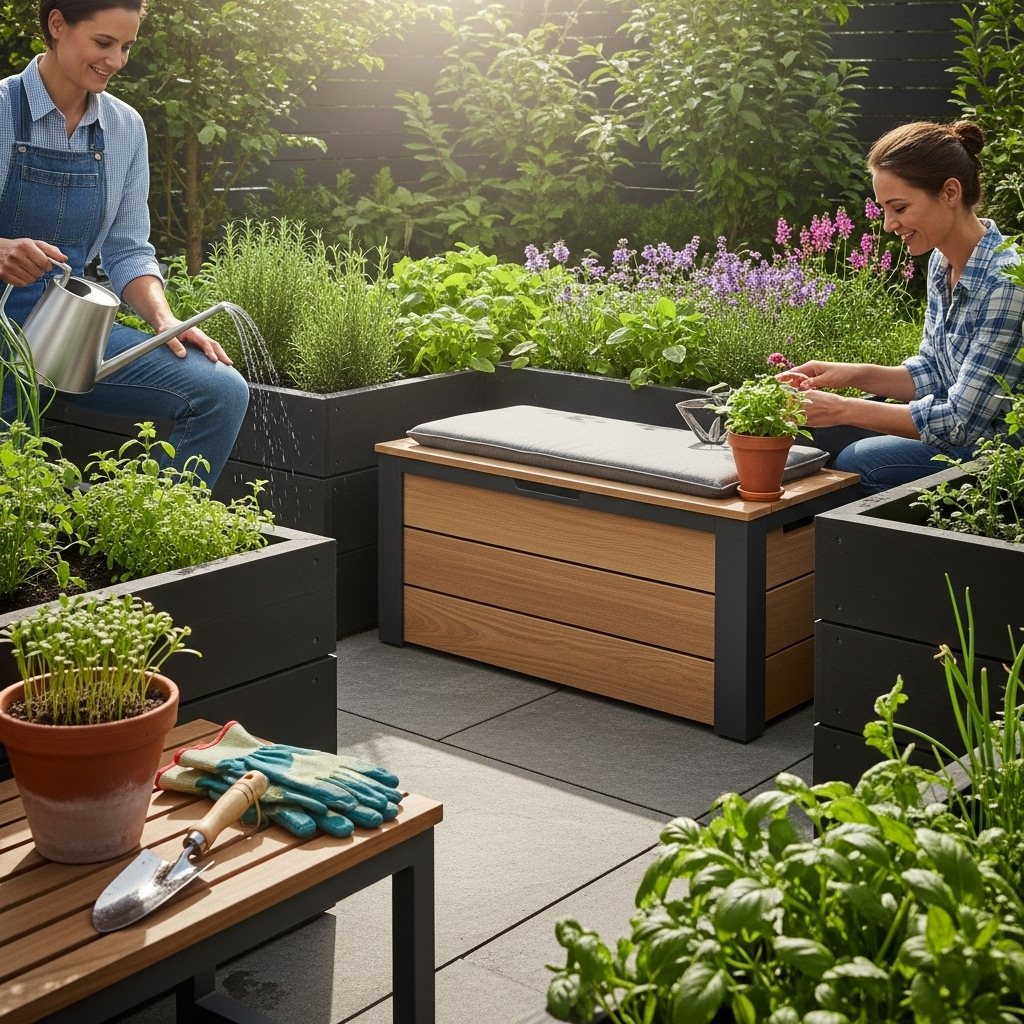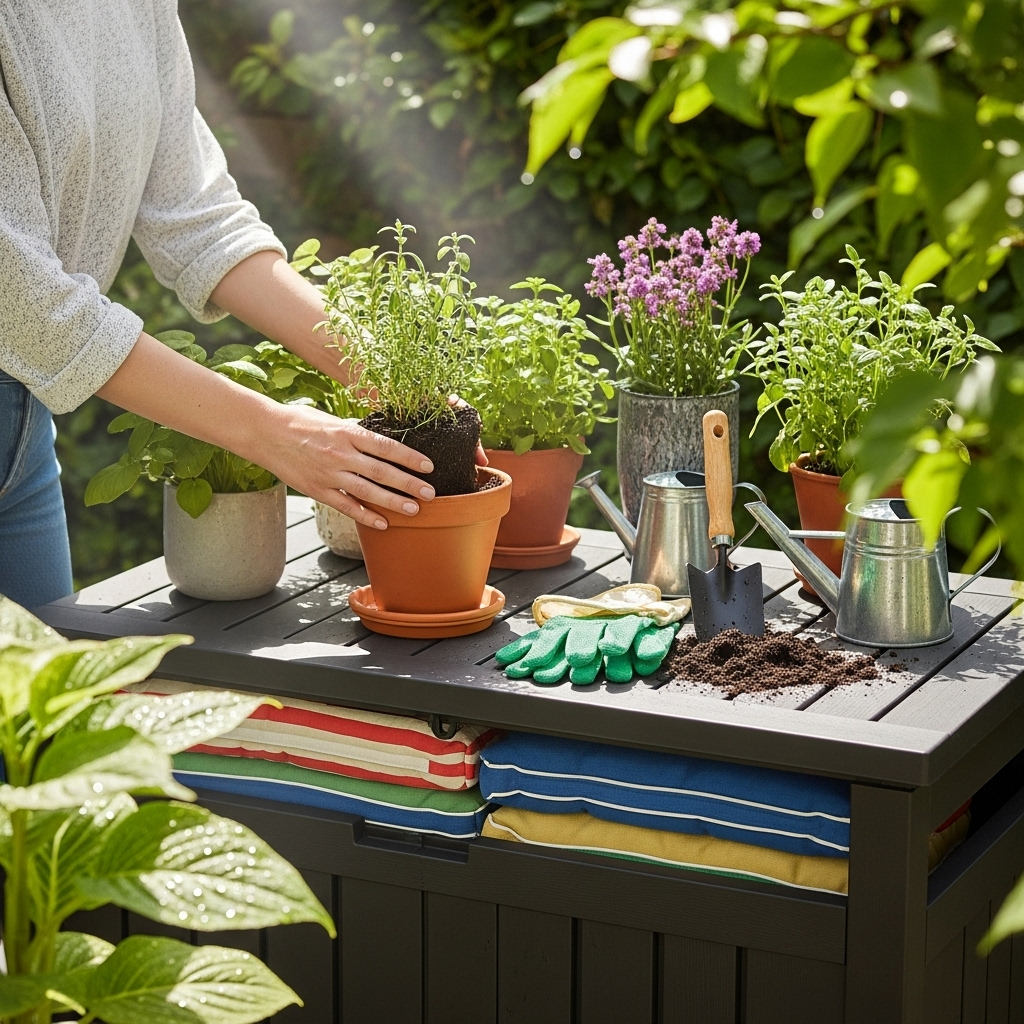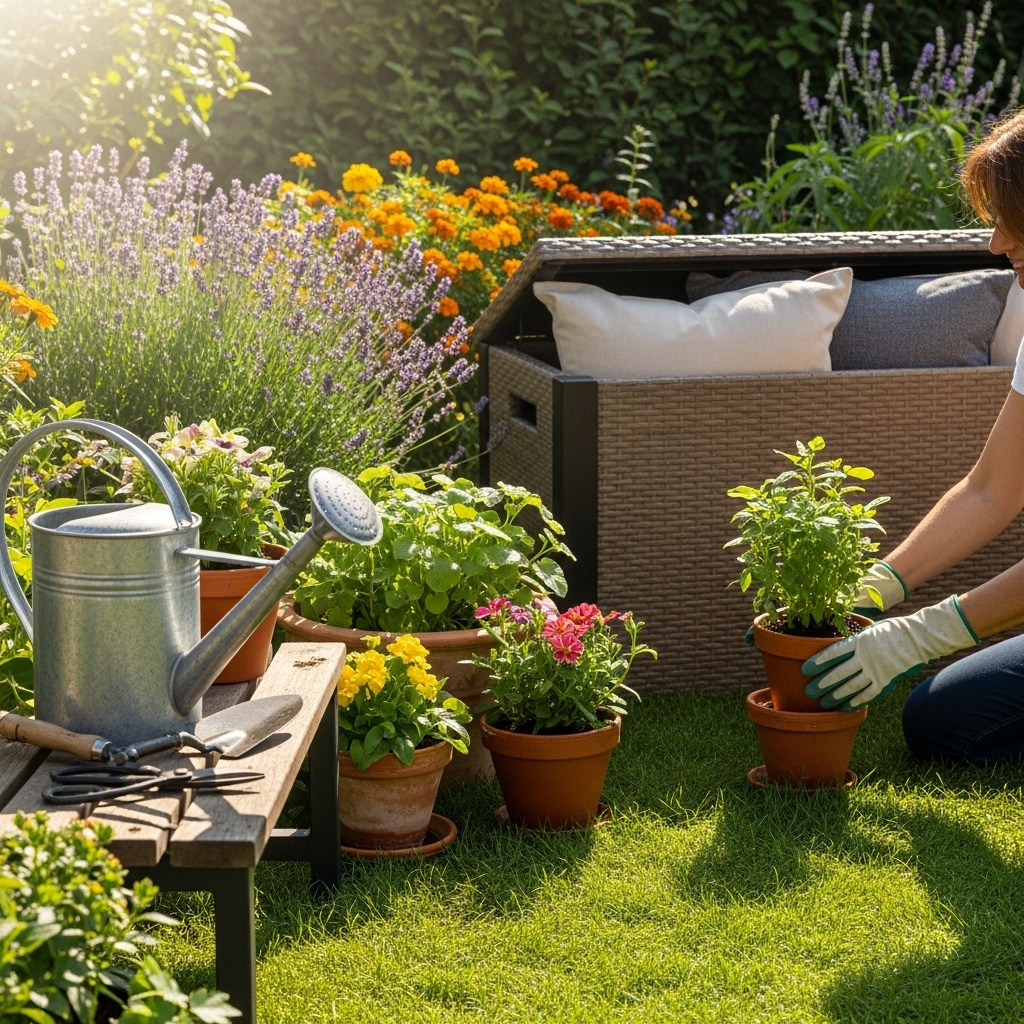Quick Summary: Essential storage boxes for outdoor furniture cushions protect them from weather, extending their life and keeping your patio tidy. Look for durable, waterproof, and ventilated options that fit your space and budget. Investing in the right storage solution saves money and hassle.
Hey there, fellow garden lovers and home organizers! We all adore our outdoor furniture, right? Those comfy cushions make our patios and decks the perfect spot for relaxing, entertaining, and soaking up that lovely fresh air. But when the season changes, or when a sudden downpour threatens, what do you do with those plump cushions? Simply leaving them out can lead to faded colors, soggy interiors, and even mildew. It’s a common frustration for many of us, and it can feel like a chore to keep them looking their best. Well, don’t you worry! Today, we’re going to dive into the wonderful world of storage boxes for outdoor furniture cushions. We’ll explore the best ways to protect your investment, keep your outdoor space looking neat, and make those cushions last for seasons to come. Get ready to discover easy, effective solutions that are perfect for any home!
Why Proper Storage for Outdoor Cushions Matters
It might seem like a small detail, but properly storing your outdoor furniture cushions is a game-changer. Not only does it keep them looking great, but it also saves you money in the long run. Think about it: those cushions are an investment! Exposing them to the elements—sun, rain, snow, and even dew—can cause irreversible damage.
The Enemies of Outdoor Cushions
- Moisture: Prolonged dampness is a cushion’s worst enemy. It breeds mold and mildew, which not only look unsightly but can also create a musty smell and even be a health hazard.
- UV Rays: The sun is wonderful, but its powerful UV rays can fade fabric colors, making your once vibrant cushions look dull and washed out.
- Insects and Pests: Spiders, ants, and other little critters love cozy, dark places. Your unprotected cushions can become an inviting home for unwelcome guests.
- Debris: Leaves, dirt, pollen, and bird droppings can accumulate, staining the fabric and making cleaning a much bigger task.
By understanding these threats, it becomes clear why a good storage solution is so important. It’s about protection, preservation, and making your outdoor experience more enjoyable year after year.
Choosing the Right Storage Box: What to Look For

When you’re on the hunt for storage boxes for outdoor furniture cushions, you’ll find a variety of options. The key is to select one that best suits your needs, your climate, and your outdoor space. Here are the crucial features to keep in mind:
Key Features to Consider
- Material Durability: Look for materials that can withstand the elements in your region. Common choices include resin, wood, metal, and fabric.
- Water Resistance: This is non-negotiable. The box should keep moisture out. Check for features like sealed lids and drainage holes (if applicable, to prevent water from pooling inside).
- Ventilation: While you want to keep rain out, a little airflow can help prevent mildew. Some boxes have built-in vents or are designed to allow minimal air circulation.
- Size and Capacity: Measure your cushions! Make sure the box is large enough to hold all your cushions comfortably without stuffing them in, which can cause damage. Consider if you need storage for dining cushions, lounge cushions, or both.
- Ease of Use: Can you open and close it easily? Is it heavy or light to move? Some boxes have wheels, which can be a lifesaver if you plan to move it around.
- Security: If you live in an area prone to theft or strong winds, a box with a lockable lid can offer peace of mind.
- Aesthetics: You want the storage box to complement your outdoor decor, not detract from it. Many styles blend seamlessly with different patio furniture sets.
Types of Storage Boxes for Outdoor Furniture Cushions
Let’s explore some of the most popular types of storage solutions available. Each has its own set of pros and cons, so consider which might be the best fit for your garden setup.
1. Deck Boxes / Patio Storage Boxes
These are perhaps the most common and versatile option. They are essentially large, sturdy containers designed specifically for outdoor use. They come in a wide range of materials and styles.
Common Materials for Deck Boxes:
- Resin/Plastic: Very popular due to their affordability, low maintenance, and resistance to rot, rust, and insects. They are often UV-treated to prevent fading. Many are water-resistant, but double-check for seals and drainage.
- Wood: Offers a classic, attractive look that can match wooden furniture. Cedar, redwood, or teak are good choices for their natural resistance to decay and insects. However, wood requires more maintenance (sealing, staining) to prevent warping and rot.
- Metal: Often made from aluminum or steel, metal boxes are durable and can be stylish. Look for powder-coated finishes to prevent rust. They can get hot in direct sun.
- Wicker/Rattan (Resin): These mimic the look of natural wicker but are made from durable, weather-resistant resin. They offer good ventilation and an attractive, airy aesthetic.
Pros of Deck Boxes:
- Generally very durable and weather-resistant.
- Offer substantial storage capacity.
- Many are designed to double as benches or extra seating.
- Come in a vast array of sizes, styles, and colors.
Cons of Deck Boxes:
- Can be more expensive than fabric-only options.
- Heavier materials can be difficult to move.
- Some plastic or wood options might not be entirely waterproof without good seals.
2. Outdoor Storage Benches
Combining functionality, these are benches that have a hidden storage compartment inside. They are a fantastic space-saving solution for smaller patios or decks.
Pros of Storage Benches:
- Dual purpose: provides seating and storage.
- Great for maximizing space.
- Can create a more cohesive look for your outdoor area.
Cons of Storage Benches:
- Capacity is usually less than a dedicated deck box.
- Accessing cushions might require removing people from the bench.
- Lid might not be as robustly sealed as a deck box.
3. Storage Chests / Trunks
Similar to deck boxes but often with a more traditional trunk-like appearance. They can add a decorative element to your patio while providing ample storage.
Pros of Storage Chests:
- Often come with a more decorative or antique look.
- Can be very sturdy.
- Lids are usually hinged and easy to operate.
Cons of Storage Chests:
- May not be as weather-sealed as some deck boxes unless specifically designed for it.
- Some styles can be quite heavy.
4. Fabric Storage Bags / Covers (Temporary or Light-Duty Solutions)
While not a “box” in the traditional sense, large, sturdy fabric bags or specially designed cushion covers can be a budget-friendly option, especially for milder climates or for storage during shorter off-seasons. Look for water-resistant and UV-resistant materials.
Pros of Fabric Storage:
- Very affordable.
- Lightweight and easy to store when not in use.
- Can hold a surprisingly large number of cushions.
Cons of Fabric Storage:
- Less durable than hard-sided options.
- May not offer the same level of protection against extreme weather, pests, or impact.
- Not ideal for long-term, all-weather storage.
For a truly robust solution, especially in climates with significant rain or snow, hard-sided deck boxes or storage chests are generally recommended. Fabric options are better suited for very temporary needs or as an extra layer of protection inside a larger container.
DIY Outdoor Cushion Storage Ideas

If you’re a hands-on person, or if you’re looking for a budget-friendly or customized solution, a DIY project might be just the ticket! Many simple DIY storage box ideas can be surprisingly effective and add a personal touch to your home.
Simple DIY Storage Bench/Box
One popular DIY project is building a wooden storage bench. This is a great way to get exactly the size and style you want. You can find numerous plans online, or adapt existing furniture.
Basic Steps for a Wooden Storage Bench:
- Gather Materials: You’ll need lumber (weather-resistant wood like cedar is ideal), screws or nails, hinges for the lid, sandpaper, and a sealant or outdoor paint.
- Design and Measure: Decide on the dimensions based on your cushion size and available space. A good starting point is a box that’s slightly larger than your largest cushion.
- Cut the Wood: Cut your lumber to size for the base, sides, front, back, and lid.
- Assemble the Box: Screw or nail the sides, front, and back pieces together to form the main box structure. Attach the base.
- Create the Lid: Attach the lid piece to the back of the box using heavy-duty outdoor hinges. Ensure it can open and close smoothly.
- Sand and Seal: Sand down any rough edges. Apply a good quality outdoor sealant, stain, or paint to protect the wood from moisture and UV rays. This is a crucial step for longevity. For more on wood sealing, a great resource is the US Forest Service’s information on wood preservation.
- Add Optional Features: Consider adding handles for easier moving, or even a small latch to keep the lid closed.
Upcycled Options
Get creative! Old toy chests, sturdy plastic bins (ensure they are weather-proof), or even repurposing old furniture pieces can be transformed into functional cushion storage with a bit of effort and weatherproofing. Remember to drill drainage holes if you’re using a fully sealed container.
DIY Considerations:
- Weatherproofing is Key: Whatever material you use, ensure it’s properly sealed and protected against the elements to prevent damage and mildew.
- Ventilation: Consider adding small vents, especially if using plastic, to allow air circulation.
- Lid Stability: Make sure the lid is secure and can withstand wind. Hinges should be sturdy outdoor-grade ones.
DIY projects are a fantastic way to get exactly what you need while adding a custom touch that reflects your personal style. Plus, it’s often more budget-friendly!
Maintenance Tips for Your Storage Box
Once you’ve invested in or built your perfect storage solution, a little bit of regular maintenance will ensure it lasts for years and keeps your cushions in top condition.
Regular Cleaning Schedule
- Weekly/Bi-Weekly: Sweep or wipe down the exterior to remove dust, pollen, and any debris. Check the lid seal and ensure it’s free of obstructions.
- Monthly: If you notice any dirt or grime building up, give the exterior a wash with mild soap and water. For wooden boxes, check any sealant or paint for signs of wear.
- At the End of the Season: Before storing cushions for the first time, ensure the interior of the box is clean and dry. A good wipe-down with a mild disinfectant can help prevent mold or mildew from starting.
- Before and After Each Use: The best time to check your storage is when you take cushions out and put them back in. This quick check ensures everything is in order.
Specific Maintenance Tips by Material
- Resin/Plastic: Clean with soap and water or a gentle household cleaner. Avoid abrasive scrubbers that can scratch the surface.
- Wood: Reapply sealant or stain annually, or as needed, especially if you live in a harsh climate. Clean with a soft brush and mild soap.
- Metal: Wipe with a damp cloth. If you notice any rust spots on steel furniture, address them promptly with a rust reformer and touch-up paint.
- Wicker (Resin): Use a soft brush or vacuum cleaner attachment to get into the weave and remove dust. Wash with mild soap and water.
Dealing with Dampness and Mildew
Even the best storage box can sometimes end up with a bit of dampness, especially in humid climates. Here’s how to combat it:
- Ensure cushions are completely dry before storing them. If they get wet, take them out and let them air dry thoroughly in the sun if possible.
- If you notice dampness inside the box, open the lid and let it air out.
- For persistent moisture issues, consider placing a moisture absorber (like silica gel packets or charcoal briquettes designed for this purpose) inside the box.
- If you find mildew on the cushions themselves, clean them according to the manufacturer’s instructions before re-storing. A solution of one part bleach to ten parts water can often work, but always test on an inconspicuous spot first!
Protecting Your Storage Box Itself
If your storage box is directly exposed to the elements, consider these tips:
- Covers: For wooden boxes, or even sturdy resin boxes, a good quality outdoor furniture cover can add an extra layer of protection, especially during harsh weather like heavy snow or prolonged rain.
- Placement: If possible, place your storage box in a shaded area to reduce UV exposure and heat buildup. Elevating it slightly off damp ground (e.g., on a few bricks) can also help with airflow and prevent moisture from seeping in from below.
Proper maintenance is key to making your storage solution effective and extending the life of both the box and your precious cushions!
Environmental Considerations for Storage Solutions

As we at EcoPatchy love to mention, thinking about our planet is always a good thing, even when it comes to organizing our patios! Choosing sustainable storage options can make a big difference.
Eco-Friendly Material Choices
- Recycled Materials: Many outdoor products are now made from recycled plastic or metal. Look for these options when shopping for deck boxes or benches. They divert waste from landfills and often have a lower manufacturing footprint.
- Sustainably Sourced Wood: If you opt for a wooden storage box, choose wood that is certified by organizations like the Forest Stewardship Council (FSC). This ensures it comes from responsibly managed forests.
- Durable Over Disposable: The most eco-friendly choice is often the one that lasts the longest. A high-quality, durable storage box, even if it has a higher upfront cost, will likely outlast several cheaper, less durable options, reducing the need for replacements and the associated waste.
Reducing Waste
Think about the lifecycle of your storage. Can a piece of furniture be repaired rather than replaced? Can old storage be given away or repurposed before it becomes waste?
- Repair and Refurbish: Before buying new, assess if your current storage can be repaired. A loose hinge, a bit of wood rot, or faded paint can often be fixed simply.
- Donate or Sell: If you upgrade or no longer need a storage box, try donating it to a local charity or selling it secondhand. It’s a great way to give it a second life.
- DIY from Reclaimed Materials: As mentioned in the DIY section, using reclaimed wood or upcycled containers is a fantastic way to be eco-conscious and creative.
Making mindful choices about your outdoor storage can contribute to a greener lifestyle, ensuring your patio is organized and your environmental footprint is a little lighter.
Frequently Asked Questions (FAQ)
Q1: How do I know what size storage box I need for my outdoor cushions?
A1: Measure all the cushions you intend to store. Lay them flat to get an idea of their combined dimensions. Then, choose a storage box that is slightly larger than these measurements to ensure they fit comfortably without forcing, which can damage the cushions.
Q2: Are all outdoor storage boxes waterproof?
A2: Not all of them are completely waterproof. Look for descriptions that emphasize “water-resistant” or “weatherproof” with sealed lids and sturdy construction. Some might have drainage holes, which are good for preventing water pooling but might not be ideal if you experience extreme humidity and need to keep cushions bone dry.
Q3: Can I just use a regular plastic bin for outdoor cushions?
A3: You can, but ensure it’s a heavy-duty, UV-resistant plastic bin designed for outdoor use. Standard indoor plastic bins can become brittle in sunlight and may not seal well against rain. It’s also crucial to drill drainage holes in the bottom to prevent water from collecting.
Q4: My storage box is in direct sunlight. Will it damage the cushions?
A4: Yes, prolonged direct sunlight can cause cushions to fade. While the box protects them from rain, UV rays can still degrade the fabric over time. If possible, position your storage box in a shaded area of your patio. Some high-quality boxes are made with UV-resistant materials, but extra shade helps.
Q5: How often should I clean my outdoor storage box?
A5: It’s a good idea to wipe down the exterior regularly (e.g., weekly or bi-weekly) to remove dust and debris. A more thorough cleaning with mild soap and water can be done monthly or as needed. Ensuring the interior is clean and dry before storing cushions is especially important at the end of the season.
Q6: What’s the best way to prevent mildew in my storage box?
A6: First, always ensure cushions are thoroughly dry before storing them. Second, make sure the box has some form of ventilation, or open the lid periodically to allow air circulation. For extremely humid environments, consider using moisture absorbers inside the box.
Conclusion

Protecting your outdoor furniture cushions with the right storage box is a smart move for any homeowner. It’s about preserving your investment, keeping your patio tidy, and ensuring those comfortable cushions are ready for you to enjoy whenever the weather is perfect. We’ve explored the importance of proper storage, the key features to look for in a box, the different types available, and even some fantastic DIY and eco-friendly options. Remember, a little bit of effort in choosing and maintaining your storage solution can prevent a lot of heartache (and expense!) down the line. So go ahead, find the storage box that fits your space and your cushions, and get ready to enjoy many more seasons of comfortable outdoor living!
